If you’re a KomikPDF Lovers who enjoyed the dark, gritty world of Tokyo Ghoul, then you’re in for a treat! This manga, with its blend of supernatural horror, action, and complex characters, left a lasting impression on many readers. Luckily, the world of manga offers a wealth of similar titles that can quench your thirst for thrilling stories and morally grey protagonists.
From the chilling mystery of Another to the twisted psychological horror of Shiki, this list explores a variety of manga that capture the essence of Tokyo Ghoul. Whether you crave more heart-wrenching battles, captivating character development, or mind-bending plot twists, these recommendations are sure to keep you hooked.
So, buckle up KomikPDF Lovers, because we’re diving deep into the world of manga that will leave you craving more. Prepare to encounter captivating narratives, intricate world-building, and characters that will stay with you long after you turn the last page. Let’s explore the darker side of manga together!
Synopsis Tokyo Ghoul
In a world where ghouls, creatures who must consume human flesh to survive, live in secret among humans, Ken Kaneki, a shy and bookish college student, finds his life drastically changed after a near-fatal encounter with a ghoul. He is given a ghoul organ transplant, transforming him into a half-ghoul.
Torn between his human identity and his newfound ghoul nature, Kaneki struggles to adapt to this horrifying reality. He is forced to navigate the treacherous world of ghouls, where he encounters both ruthless and compassionate individuals. As he grapples with his dual nature, he must also contend with the increasingly dangerous conflict between ghouls and humans.
The series explores themes of identity, survival, and the nature of good and evil, as Kaneki fights to find his place in a world where he is no longer fully human. He is forced to make difficult choices, questioning his own morality and the very definition of humanity.
Attack on Titan

Both Attack on Titan and Tokyo Ghoul are dark fantasy anime that feature a strong sense of despair and hopelessness. Both series feature protagonists who are forced to fight against monstrous creatures: Titans in Attack on Titan and Ghouls in Tokyo Ghoul. These creatures are seen as threats to humanity and are both capable of great destruction. Both stories also explore themes of prejudice and discrimination, as the protagonists struggle to find their place in a world that fears and despises them. The worlds of Attack on Titan and Tokyo Ghoul are filled with complex characters who make difficult choices in the face of overwhelming odds. Both series are known for their intense action sequences, graphic violence, and shocking twists. Although the settings and monsters differ, they share a similar dark tone, complex characters, and exploration of challenging themes.
Synopsis of Attack on Titan
The story takes place in a world where humanity lives within three concentric walls that protect them from the Titans, giant humanoid creatures that devour humans without reason. One hundred years after the walls were erected, the Colossal Titan, a 60-meter-tall Titan, breaches the outermost wall, unleashing a horde of Titans that decimate the city. Eren Yeager, a young boy who witnesses the destruction of his home and the death of his mother, vows to exterminate all Titans.
Eren enlists in the Survey Corps, an elite military unit that ventures beyond the walls to fight the Titans. He learns to fight with the 3D Maneuver Gear, a device that allows humans to move freely through the air and attack Titans from various angles. Along with his friends Mikasa Ackerman and Armin Arlert, Eren faces countless threats from the Titans and uncovers shocking secrets about the world and his own past.
Parasyte
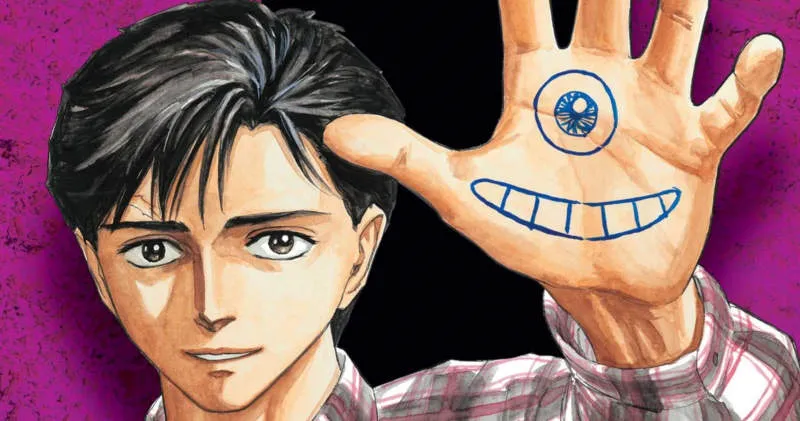
Both Parasyte -the maxim- and Tokyo Ghoul are popular anime and manga series that deal with the themes of human-parasite interaction and the blurring lines between good and evil. Both series feature protagonists who are forced to confront and fight against creatures that are both alien and terrifying, while also struggling with their own internal conflicts and moral dilemmas. The series also explore the social ramifications of these encounters, as the lines between humanity and monstrosity become increasingly blurred. While they share many similarities, each series has its own distinct style and tone, making them both unique and engaging in their own right.
Synopsis Parasyte
Parasyte is a science fiction horror manga series that follows the story of Shinichi Izumi, a high school student who becomes the host of an alien parasite. These parasites, known as Parasytes, have invaded Earth and attempt to take over human bodies by entering through the nose or ears. When one fails to enter Shinichi's body, it manages to attach itself to his right arm, forming a symbiotic relationship with him. Shinichi now has to learn to coexist with this alien creature, who he names Migi, while fighting off other Parasytes who are trying to take over other humans.
As Shinichi and Migi learn to work together, they encounter other Parasytes with different abilities and motivations. Some are violent and aggressive, while others are more cunning and manipulative. Shinichi and Migi must use their combined strength and intellect to protect themselves and the human race from the growing Parasyte threat. The series explores themes of human nature, the nature of life, and the importance of choice in a world where the line between human and alien is blurred.
Death Note
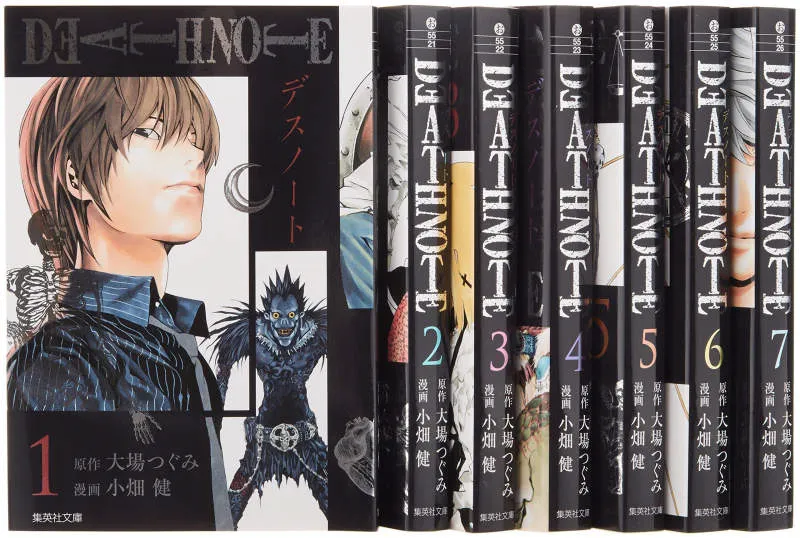
While seemingly different on the surface, both Death Note and Tokyo Ghoul share a common thematic thread: the exploration of the dark side of humanity and the consequences of wielding power. Both series feature protagonists who find themselves thrust into morally gray areas, forced to confront their own vulnerabilities and the complexities of justice. Light Yagami, the driven protagonist of Death Note, embodies the allure of power and the slippery slope of manipulating fate. Similarly, Ken Kaneki, the protagonist of Tokyo Ghoul, struggles with his newfound ghoul identity and the ethical dilemmas of survival. Both series use their distinct settings and unique supernatural elements to explore the human condition, questioning the boundaries of right and wrong and the potential for good and evil within us all.
Synopsis Death Note
Light Yagami, a brilliant but bored high school student, finds a mysterious notebook called the Death Note. The notebook's instructions explain that writing a person's name in it will cause them to die. Intrigued, Light decides to use the Death Note to rid the world of criminals and create a new world order where he is God. He believes that he is a righteous judge, but his actions attract the attention of L, a legendary detective who specializes in solving complex cases.
As Light’s reign of terror grows, he is hunted by L, who suspects his true identity. The series follows a thrilling game of cat and mouse as Light and L engage in a battle of wits and intelligence, each trying to outsmart the other. The Death Note also attracts the attention of other individuals, including Misa Amane, a young woman who uses the Death Note for her own reasons, and Near, another brilliant detective who becomes L's successor.
Blue Exorcist

Both Blue Exorcist and Tokyo Ghoul are popular anime and manga series that explore the themes of supernatural creatures, human-monster conflict, and the complex inner struggles of characters who live on the fringes of society. While Blue Exorcist focuses on demon exorcism and the clash between humans and demons, Tokyo Ghoul delves into the world of ghouls, creatures that feed on human flesh, and the societal tensions they create. Both series feature compelling protagonists who struggle with their own inner demons, torn between their human nature and their supernatural abilities, leading to difficult choices and moral dilemmas. The dark and gritty aesthetic, along with the exploration of themes like identity, prejudice, and the struggle for survival, are shared elements that resonate with fans of both series.
Synopsis Blue Exorcist
Rin Okumura is a seemingly normal teenager who lives with his foster father, Father Fujimoto, in an old church. His life changes dramatically when he discovers that he is the son of Satan, the Demon King. Rin's father, Satan, attempts to take over the human world, but Father Fujimoto sacrifices himself to save Rin from being possessed by Satan. Rin vows to become an Exorcist and defeat Satan to avenge his father's death. To achieve this goal, he enrolls at the True Cross Academy, a prestigious school for Exorcists.
At the Academy, Rin is initially reluctant to learn, but he quickly finds himself caught in a world of demons and magic. He faces numerous challenges as he trains alongside his fellow Exorcists, including his younger brother Yukio, who is also an Exorcist. Rin's unique demonic powers and his determination to fight against evil make him a powerful force in the battle against Satan and his legions.
Ajin: Demi-Human

Both Ajin: Demi-Human and Tokyo Ghoul explore the themes of societal prejudice and discrimination against a marginalized group, in this case, the Ajin and ghouls, respectively. Both series portray the struggle of these individuals to survive in a world that fears and ostracizes them, highlighting the psychological and physical torment they endure. Both series also delve into the moral ambiguity of the conflict, questioning the justifications for violence and the ethical boundaries of human and “monster” interaction. Though their visual styles and specific powers differ, both series effectively capture the anxieties and societal anxieties surrounding the acceptance of the “other” in a world that is often quick to fear and judge.
Synopsis: Ajin: Demi-Human
Ajin: Demi-Human is a Japanese dark fantasy manga series written by Gamon Sakurai and illustrated by Tsuina Miura. The story follows Kei Nagai, a high school student who is involved in a fatal accident. However, he doesn't die and awakens as an Ajin, a being with supernatural abilities that are hidden from the public eye. Ajin are feared and hunted by the government, and Kei quickly finds himself on the run from both the authorities and a mysterious organization known as the "Black Ghost".
As Kei tries to survive and understand his newfound abilities, he meets other Ajin, including Kaito, a young and resourceful Ajin who becomes Kei's closest ally. Together, they must navigate a world where they are ostracized and hunted, while also trying to uncover the truth behind the Ajin's existence and the government's secret agenda.
Seraph of the End

Both Seraph of the End and Tokyo Ghoul are popular anime and manga series that share striking similarities. Both explore a world where humanity is threatened by powerful, monstrous beings, forcing survivors to adapt and fight for their survival. In Seraph of the End, vampires have taken over the world, while Tokyo Ghoul features ghouls, creatures that feed on human flesh. Both series delve into themes of prejudice, survival, and the blurred lines between good and evil. The protagonists in both stories are caught between two worlds, struggling to reconcile their humanity with the powers they possess. These common elements contribute to the compelling and thought-provoking nature of both franchises, drawing audiences into their gritty and captivating narratives.
Synopsis of Seraph of the End
In a world ravaged by a deadly virus that wiped out most of humanity and turned the remaining survivors into vampires, Yuichiro Hyakuya and his friends are held captive by the vampires. Seeking to escape their cruel fate, they hatch a daring plan. However, their escape attempt ends in tragedy, leaving Yuichiro the sole survivor. Now consumed by a thirst for vengeance, he joins the Moon Demon Company, a unit of the Japanese Imperial Demon Army, to fight against the vampires and reclaim what they have taken from him.
Yuichiro, along with his comrades Mikaela Hyakuya and Krul Tepes, embark on a perilous journey filled with battles against powerful vampires, unraveling secrets about the origins of the virus and the true nature of their enemies. With each step, they face agonizing choices that challenge their humanity and the lines between good and evil.
D.Gray-man

Both D.Gray-man and Tokyo Ghoul are popular manga series that explore dark fantasy themes. While they have their own unique elements, they share certain similarities that appeal to fans of both. Both series feature protagonists who are struggling to accept their identity and purpose in a world filled with terrifying creatures. They also explore themes of sacrifice, loss, and the search for hope in the face of overwhelming odds. Furthermore, both manga feature compelling and complex characters who are driven by strong motivations, even if their methods are sometimes questionable.
Synopsis D.Gray-man
D.Gray-man follows the journey of Allen Walker, a young exorcist who fights against the Millennium Earl, a powerful being who seeks to destroy the world. Allen has the power of the "Innocence," an anti-Akuma weapon that grants him superhuman abilities and the ability to seal away Akuma, demonic beings created by the Earl. Joined by the Black Order, an organization dedicated to fighting the Earl, Allen travels the world, encountering other exorcists, Akuma, and the Earl's minions.
As Allen progresses in his journey, he uncovers the dark secrets of the Earl's past and his own connection to him. He must confront his own inner demons and the burden of his powers while fighting for the survival of humanity against a seemingly unstoppable foe. Along the way, Allen and his comrades face numerous challenges, battling powerful Akuma, facing betrayal, and questioning their own beliefs.
Elfen Lied

Both Elfen Lied and Tokyo Ghoul are anime and manga series that explore the themes of discrimination, violence, and the human condition. They both feature protagonists with abnormal abilities who are ostracized by society and forced to fight for survival. Lucy from Elfen Lied and Kaneki from Tokyo Ghoul both struggle with their newfound powers and the moral dilemmas they face as a result. Both series also feature graphic violence and disturbing imagery, which can be both shocking and thought-provoking. Although the specifics of their powers and the world they inhabit differ, both series offer a compelling exploration of the complexities of human nature and the struggle for acceptance.
Synopsis Elfen Lied
Elfen Lied is a Japanese manga series written and illustrated by Lynn Okamoto. The story revolves around Lucy, a Diclonius, a species of human with horns and psychic powers. Lucy is a powerful Diclonius who escapes from a laboratory and is hunted by the government. She loses her memory and takes on the human identity of Nyu. Kouta, a young man who finds Nyu injured, takes her in and tries to help her. However, Lucy's true identity and violent nature soon surface, leading to a conflict between her and the government.
Elfen Lied explores themes of violence, identity, and the nature of humanity. The series is known for its graphic violence and mature themes. It also features a complex and often ambiguous moral landscape, with characters who are both victims and perpetrators of violence. The manga has been adapted into an anime series and a live-action film. Despite its controversial content, Elfen Lied has gained a dedicated following for its compelling story, strong characters, and thought-provoking themes.
Deadman Wonderland

Both Deadman Wonderland and Tokyo Ghoul are popular manga series that share several striking similarities. Both feature protagonists who are forced to survive in a brutal world where humans and monstrous creatures coexist. Ganta Igarashi from Deadman Wonderland and Ken Kaneki from Tokyo Ghoul are both thrust into this dangerous world against their will, and they must learn to adapt and fight for their survival. Both series also explore themes of violence, social injustice, and the blurred lines between good and evil. While Deadman Wonderland focuses on a prison filled with people with superhuman abilities, Tokyo Ghoul centers around a world where ghouls, creatures who feed on human flesh, live in secret among humans. Despite the different settings, both series delve into the struggle for survival in a world where ordinary people are forced to confront their deepest fears.
Synopsis Deadman Wonderland
Deadman Wonderland is a dystopian manga series set in a post-apocalyptic Japan, where a massive earthquake destroyed much of the country. The story centers around Ganta Igarashi, an ordinary high school student who gets framed for the murder of his entire class. Sentenced to death, he's transferred to Deadman Wonderland, a prison that doubles as a twisted amusement park where inmates compete in deadly games for survival. While there, Ganta discovers he has a hidden power called the "Deadman Factor," which grants him superhuman abilities and allows him to control blood.
Ganta must navigate the treacherous world of Deadman Wonderland, battling other prisoners with their own unique powers, uncovering the truth behind his classmates' murder, and ultimately seeking revenge against the mysterious organization responsible for his situation. Throughout his journey, Ganta must constantly question his sanity and morality as he confronts the brutal realities of his imprisonment and the true nature of the Deadman Factor.
Black Bullet
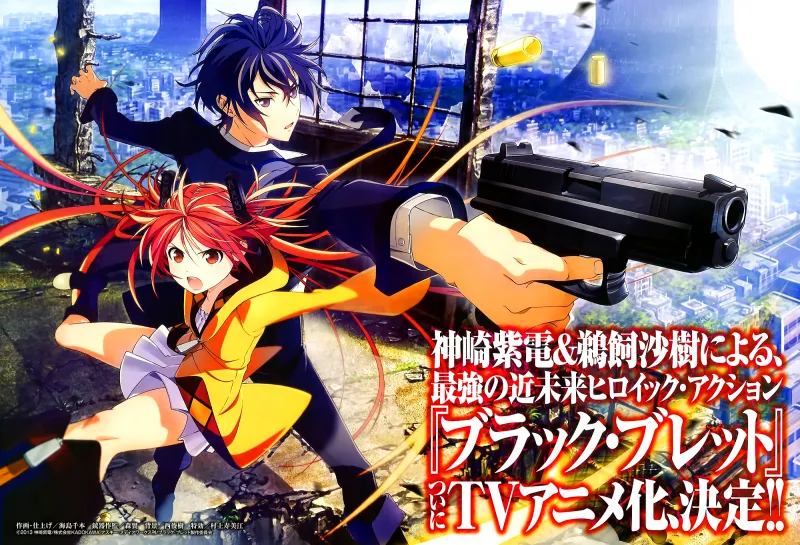
Both Black Bullet and Tokyo Ghoul are popular anime and manga series that share similarities in their themes and settings. Both explore a world where humanity faces a devastating threat from monstrous creatures. In Black Bullet, these creatures are known as Gastrea, while in Tokyo Ghoul, they are called Ghouls. Both series feature protagonists who possess unique abilities to fight these threats and must navigate a world where humans and creatures live in fear and suspicion of each other. Additionally, both series delve into the complexities of human nature, examining themes of survival, sacrifice, and the moral dilemmas that arise when facing such extraordinary dangers.
Synopsis of Black Bullet
In the year 2021, humanity is on the brink of extinction. A mysterious virus known as Gastrea has transformed much of the world into a wasteland, and the remaining survivors have been forced to live in isolated cities protected by giant walls. The only way to combat the Gastrea is with the help of special children known as "Cursed Children," who possess unique abilities and are immune to the virus. One such Cursed Child, named Rentaro Satomi, is a former military cadet who is forced to work as a "Promoter" for a powerful corporation. He is partnered with a Cursed Child named Tina Sprout, who is known for her remarkable power and her violent nature.
The story follows Rentaro and Tina as they battle the Gastrea and try to uncover the secrets behind the virus. Along the way, they face a variety of challenges, including political intrigue, corporate espionage, and the dangers of their own powers. As they fight for survival, Rentaro and Tina must also learn to trust each other and overcome their differences.
Highschool of the Dead

Both Highschool of the Dead and Tokyo Ghoul explore the dark side of humanity and societal collapse in the face of a terrifying threat. Highschool of the Dead centers on a group of high school students navigating a world overrun by zombies, while Tokyo Ghoul features a protagonist thrust into a hidden world of Ghouls, cannibalistic creatures who prey on humans. Both series showcase brutal violence and gore, portraying the desperate fight for survival in a world where the familiar has become monstrous. Despite their differing monster types, both series depict the loss of innocence, the struggle to maintain humanity, and the psychological toll of living in a world filled with danger and uncertainty.
Synopsis Highschool of the Dead
Highschool of the Dead follows a group of high school students and their school nurse who find themselves in the midst of a catastrophic event as the world is ravaged by a deadly pandemic that turns humans into flesh-eating zombies. Led by Takashi Komuro, the group must navigate through the chaos and violence, fighting for survival while trying to make sense of their new reality.
As they encounter both allies and enemies in their journey, the group faces not only the external threats of the zombie apocalypse but also the internal conflicts and moral dilemmas that arise in a world where the line between humanity and savagery becomes increasingly blurred. With intense action, suspenseful plot twists, and complex character dynamics, Highschool of the Dead explores themes of survival, loyalty, and the darkest aspects of human nature in the face of an apocalyptic disaster.
Shiki
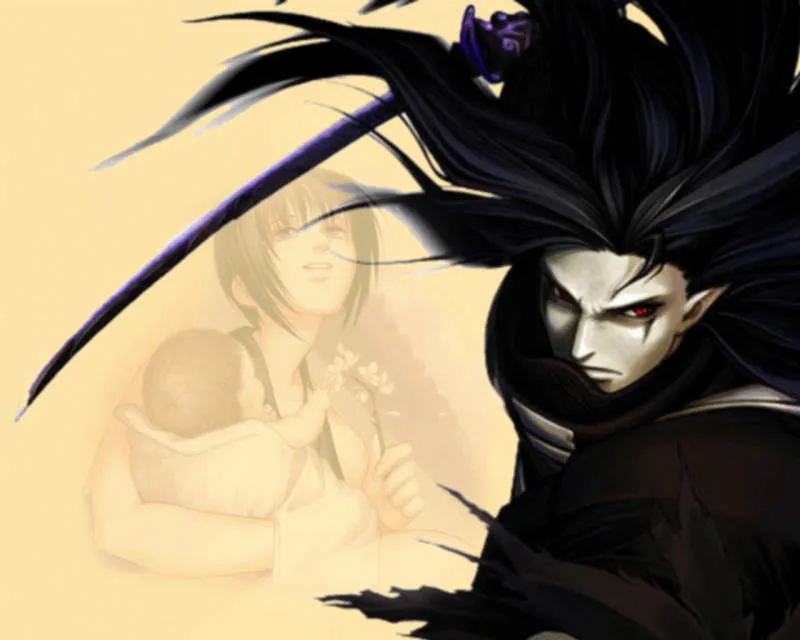
While they share a similar dark and gritty aesthetic, Shiki and Tokyo Ghoul differ significantly in their approach to the supernatural. While Tokyo Ghoul focuses on the struggle between humans and ghouls, Shiki delves into the complexities of a village plagued by a mysterious disease that turns its inhabitants into vampires. Both series explore themes of prejudice, fear, and the moral ambiguity of violence, but Shiki‘s slow-burning horror and emphasis on psychological tension set it apart. While Tokyo Ghoul presents an action-packed narrative with a clear-cut conflict, Shiki delves deeper into the psychological effects of the supernatural and the blurring lines between good and evil.
Synopsis Shiki
Shiki is a Japanese horror manga series written and illustrated by Fuyumi Ono. The story follows the events in the rural village of Sotoba, where a mysterious disease begins to spread. The disease, known as "Shiki," turns the infected into nocturnal creatures that prey on humans. As the villagers begin to die off in increasing numbers, a young doctor named Toshio Ozaki, along with a few others, suspect that something sinister is at play. With each death, the lines between human and monster blur, and the villagers are forced to confront the darkness that lurks within their community.
Shiki delves into themes of fear, paranoia, and the fragility of human life. It explores the complexities of morality and the consequences of unchecked ambition. The manga's chilling atmosphere, well-developed characters, and thought-provoking plot have made it a highly acclaimed and popular work in the horror genre. Shiki is a story that will stay with you long after you finish reading it.
Future Diary

While seemingly different on the surface, Future Diary and Tokyo Ghoul share some intriguing thematic similarities. Both series explore the darker side of humanity, delving into the psychological struggles of individuals caught in terrifying situations. The protagonists, Yukiteru Amano and Ken Kaneki, are ordinary people thrust into extraordinary circumstances, forced to confront their own mortality and the brutality of the world. Both series feature intense power struggles and explore themes of survival, identity, and the blurred lines between good and evil. The protagonists navigate a world where their own existence is constantly threatened, grappling with the moral dilemmas that arise when faced with unimaginable dangers.
Synopsis Future Diary
Future Diary is a Japanese manga series written and illustrated by Sakae Esuno. The story follows Yukiteru Amano, a shy and withdrawn high school student who is given a "Future Diary" by Deus Ex Machina, a god of time and space. The diary is a phone-like device that shows Yukiteru glimpses of his future, but it is not always clear or complete. Deus Ex Machina explains that he has chosen Yukiteru and eleven other people to participate in a "survival game," where the only way to survive is to be the last one standing.
The other participants, known as "Diary Holders," are also given diaries with various abilities and personalities. They must compete against each other in a deadly game of cat-and-mouse, using their future knowledge to outwit and eliminate their opponents. As the game progresses, Yukiteru learns to rely on his own strengths and the support of his friends, especially Yuno Gasai, a seemingly kind and cheerful girl who harbors a dangerous obsession with him.
Claymore
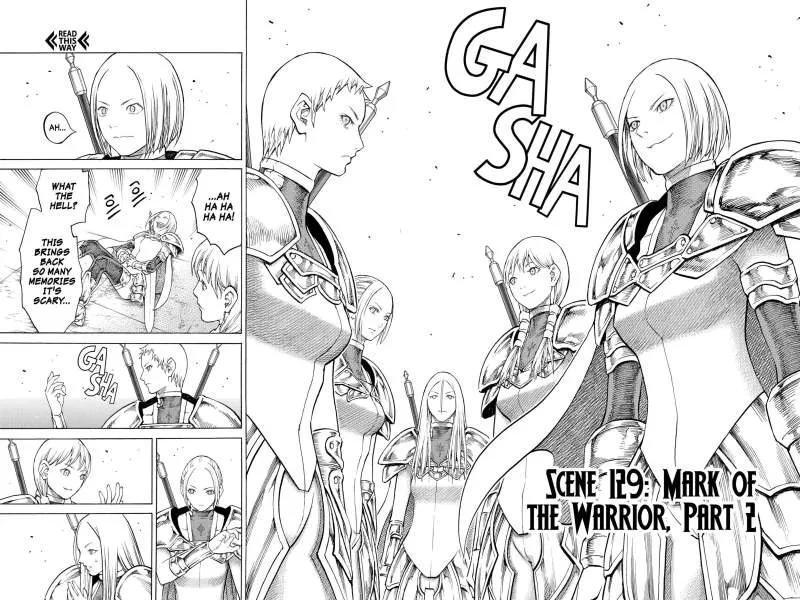
Both Claymore and Tokyo Ghoul are popular manga series that explore the themes of humanity and monstrosity. Both series feature protagonists who are half-human, half-monster and struggle to reconcile their dual nature. In Claymore, the Claymores are female warriors who hunt down monstrous creatures called Yoma, while in Tokyo Ghoul, the protagonists are ghouls who must live in secrecy and fight to survive in a human world that fears them. Both series explore the consequences of prejudice and the challenges of living in a society that rejects those who are different. Additionally, both manga series have gained significant popularity for their dark and gritty atmospheres, well-developed characters, and action-packed storylines.
Synopsis of Claymore
Claymore is a dark fantasy manga series that follows the journey of Clare, a powerful warrior known as a Claymore. In a world plagued by monstrous creatures called Yoma, Claymore are half-human, half-Yoma beings tasked with hunting and eliminating them. They are trained and controlled by an organization that views them as weapons, but also as tools to maintain the fragile peace between humans and Yoma.
As Clare journeys throughout the land, she encounters various Yoma, each with unique powers and abilities. Along the way, she befriends other Claymore and learns about the organization's secrets and the dark history behind their creation. With every battle, Clare grapples with her own humanity and the burden of her existence as a weapon. The manga explores themes of identity, loss, and the nature of good and evil in a world where the lines between humanity and monstrosity are constantly blurred.
Hellsing

Both Hellsing and Tokyo Ghoul explore themes of humanity and monstrosity, focusing on protagonists caught between two worlds. Alucard in Hellsing and Ken Kaneki in Tokyo Ghoul are both characters struggling with their internal conflicts. Both series feature intense action sequences, supernatural elements, and graphic violence, though with differing tones. Hellsing delves into a world of vampires and the fight for the sanctity of humanity, while Tokyo Ghoul examines the societal repercussions of co-existence with ghouls. Both series create compelling characters and world-building, while offering exciting narratives that resonate with readers.
Synopsis Hellsing
Hellsing is a manga series by Kouta Hirano that follows the adventures of the Hellsing Organization, a secret British organization dedicated to fighting vampires and other supernatural threats. The story focuses on Alucard, the organization's most powerful weapon, a centuries-old vampire who serves the Hellsing family. Alongside him are Integra Fairbrook Wingates Hellsing, the current head of the organization, and her loyal servant, Seras Victoria, a former police officer who was turned into a vampire by Alucard.
As the series progresses, the Hellsing Organization faces off against a growing number of enemies, including the Iscariot, a rival organization of vampire hunters; the Millennium, a Nazi organization bent on creating a new vampire army; and a variety of other supernatural creatures. Along the way, the characters confront moral dilemmas and the nature of good and evil, and they must learn to work together to survive in a world where the lines between human and monster are blurred.
